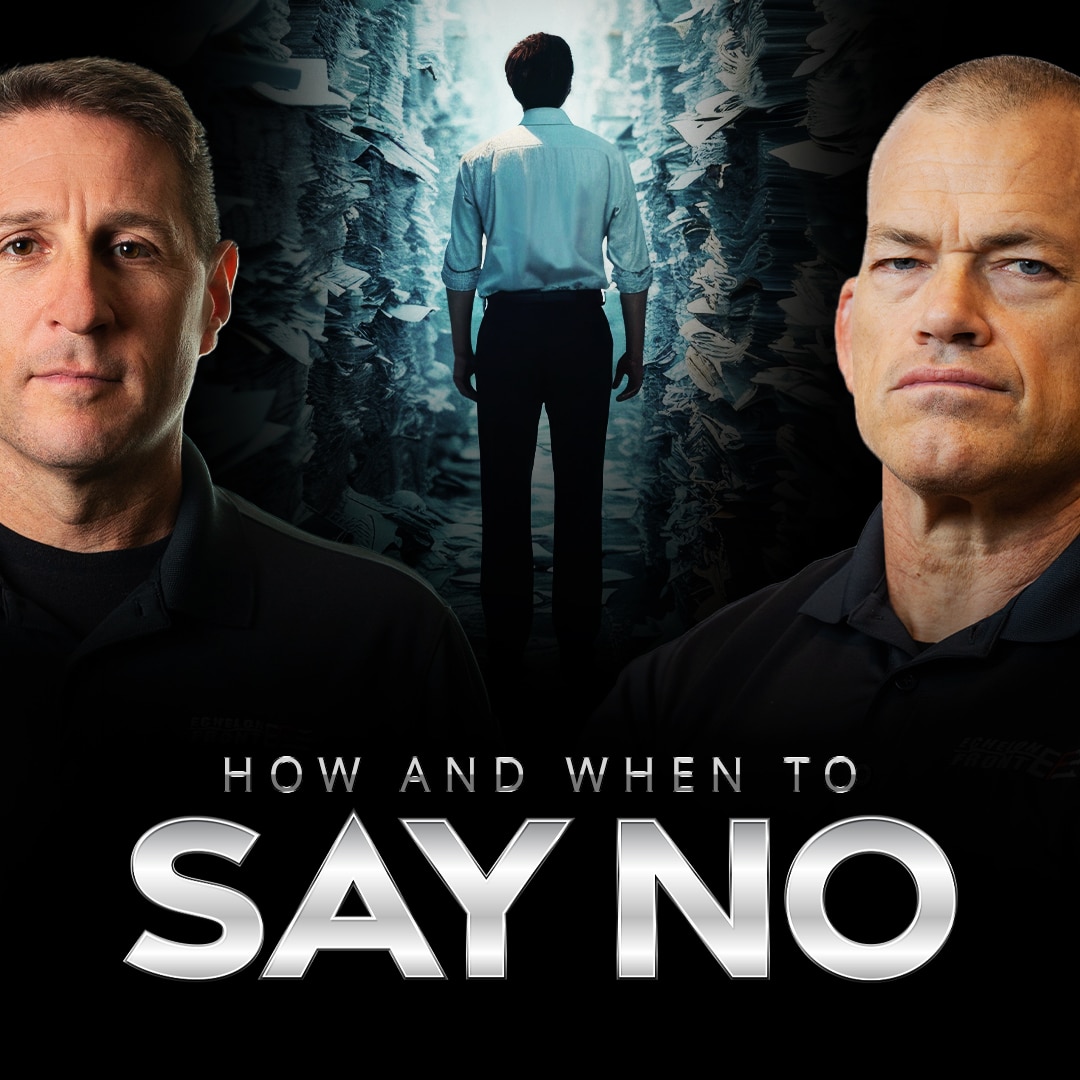How do you set boundaries? “When to say yes and how to say no” is a question we often hear, especially from people who are burnt out and feel they are doing everything for everyone. They want to learn how to say no, and how to set boundaries. However, this may not be the solution they really need. The mainstream stereotype of setting boundaries may not be the most effective way to solve problems.
Setting Boundaries: Perceived Misalignment
When I first heard this idea of setting boundaries: when to say yes and how to say no, I felt there was potential misalignment with Extreme Ownership principles. Some of the ideas around boundaries that are found in mainstream media do directly violate what we teach at Echelon Front. Even just the phrase itself, “setting boundaries,” provides a mental image that seems contrary to the first Law of Combat: Cover and Move. Cover and Move is all about building relationships to create effective teamwork. The term “setting boundaries” made me think of putting up a wall or barrier between me and another person, and that is not conducive to building a good relationship with someone.
In fact, as I began doing my research, some of the demonstrations I saw for setting boundaries were extremely disconcerting. For example, in one video, I saw they were explaining how to address a friend who shows up to the movies to meet you 20 minutes late. They suggested that you directly tell them how they made you feel disrespected by not showing up on time. This is the opposite of Extreme Ownership and Cover and Move which are two of the core concepts we teach at Echelon Front. To me, this revealed that our natural tendencies as human beings are difficult to overcome. It seems easier to blame the other person for being late, that is our natural tendency. Our ego tells us a bunch of reasons why it is their fault – they are always late, they don’t respect my time, they never pay attention when I’m talking to them, etc. But these are ultimately excuses, and if we let these excuses drive our decision-making, we will hurt our relationship rather than improve it and create the outcome we want.
As I continued to research this topic independently, I found several direct sources that helped me better understand what setting boundaries is truly about. What I found is very much aligned with Extreme Ownership, but unfortunately, we have been fed incorrect information about how to use the idea of setting boundaries. In this article, I will detail how we can view and apply setting boundaries – when to say yes and how to say no – by correctly applying Extreme Ownership leadership principles.
Boundaries Are A Tool
The first thing I realized is that setting boundaries is a tool to be used as a last resort. We talk about accountability in a similar way. Ideally, if I am having to resort to accountability, I have exhausted all of my other leadership tools to try to solve the problem without success. In the same way, if I have to set an actual boundary with someone, it should be the absolute last resort because I haven’t been able to achieve the desired outcome through other methods. Here are a few of the other methods you should be employing before resorting to setting boundaries:
- Detach: When you get frustrated by someone else’s behavior instead of jumping to setting a boundary through a direct conversation, detach. Detach from that emotion and your ego and your perspective. Put yourself in their shoes and try to figure out what is going on.
- Asking earnest questions: Once you’ve detached from that initial emotional response and you’re looking at things from their perspective, ask earnest questions. Earnest questions are questions to which you plan to actively listen to their response and react accordingly. These are not leading questions where you’re trying to get them to the answer you want. These are legitimate questions that help you better understand what is going on.
- Take Ownership: As you are asking these questions, you should be listening for your opportunity to take ownership. How did you contribute to this problem? What did you do or not do that led to this situation? Did you explain the behind why what you were asking for? Once you determine what you need to do differently, take ownership for it and correct your mistake.
- Escalation: Unfortunately, this issue might continue to persist even after you take ownership and correct your behavior. If that is the case, you might need to escalate your directness. You might have to move from: “You set the meet-up time, and we confirmed it earlier today, is everything ok?” to “Should we start meeting about 30 minutes later since that time seems to be easier for you to make?” for example. And, when you have these conversations, you always want to be cognizant of your tact, tone, timing, and delivery so that you are doing everything possible to preserve your relationship.
Hopefully, by taking ownership, you can quickly solve the problem. Even if you have to escalate, at a certain point in that escalation, most people will understand and get aligned with you, and you won’t have to be more direct. However, if you have to continue escalating, you may reach a point where you have to actually set a boundary to achieve the desired outcome. If you reach that point, before you set a boundary, you should reflect on whether or not this issue is actually worth the loss of the relationship. Because, when you set that boundary and put up that wall, you will forever change your relationship with that person, and there is always a chance that it damages it enough to lose that relationship. There might be some problems that are worth that risk, but they are rare. Be sure it’s worth jeopardizing that relationship before you set a boundary.
Setting Boundaries = Self-Discipline
As I was researching, I came across a few academic sources that explained the clinical nature of setting boundaries, and what they described is perfectly aligned with one of our core concepts at Echelon Front – Self-Discipline. Our co-founder’s mantra is Discipline = Freedom, and that is absolutely true when it comes to setting boundaries. However, the discipline he is referring to must be self-discipline, not imposed discipline. The mainstream view of boundaries is an imposed restraint you put on someone else, but that is actually not how it was intended because, as we all know, you can’t control other people. Instead, the healthiest version of setting boundaries is actually setting them for yourself (i.e. self-discipline). Here’s an example.
I have an alarm on my phone for every weekday. It goes off at 5:00 PM, and the alert is to remind me to go pick up my daughter from daycare. The rule I have set for myself is that when that alarm goes off, I go get her, and I spend my evening with her until she goes to bed. I do not allow myself to work during that time. If I have work to do, I do it after she goes to bed. That is a boundary I have set for myself. Now, I have never told any of my co-workers not to call me during this time, and I do not ignore calls or texts from them during this time either. It is not a boundary I am setting with them; it is my own self-discipline to ensure I am maximizing my time with my daughter instead of being distracted by email or other tactical tasks I need to complete.
This is how we can set boundaries correctly: by taking ownership of our own behavior, enacting self-discipline to create the work/life balance we need, and remaining flexible to adjust that balance as needed.
Always Respect Other People’s Boundaries
The last thing I realized about setting boundaries as I concluded my research was that we should always respect the boundaries of others. This is perfectly aligned with Cover and Move and building relationships. Two of the core tenets of a relationship are respect and listening. When I prove to people that I am listening to them by respecting their boundaries, I am showing them that I care about them, and my relationship with them will continue to improve. And, ideally, you are doing this without that person ever having to tell you about that boundary.
I love working at Echelon Front, and I love the team I work with. They all know that I will do anything for them. That includes answering calls and text messages as quickly as I can. But, we all live in different time zones. So, there are absolutely times when I get those calls and texts at inconvenient hours of the day for me. And, I have never once had an issue with that or indicated in any way that I wanted that to change. However, at the beginning of the year, my boss told me that his goal for this year was to not contact me after 5:00 PM in my time zone so that I could prioritize time with my family. Again, I never said anything to him, but he recognized that my family is important to me, and he also knew that I would always answer his messages anyway. So, he made it a priority to respect that boundary without me ever having to say a word.
Conclusion
So how do we determine boundaries – when to say yes and how to say no? Say yes to setting boundaries for yourself. Say yes to creating self-discipline and work-life balance by taking ownership of your own behavior. Say yes to respecting the boundaries of others to build better relationships with them. Say yes to asking questions, staying detached, improving your communication, and explaining the why behind things. Say no to trying to create boundaries for others. Say no as a last resort. And before you do, ask yourself, is it actually worth it? What boundaries (disciplines) do you need to create for yourself and for how you interact with others? Learn more about setting boundaries in our new Extreme Ownership Academy course, When and How to Say No.



